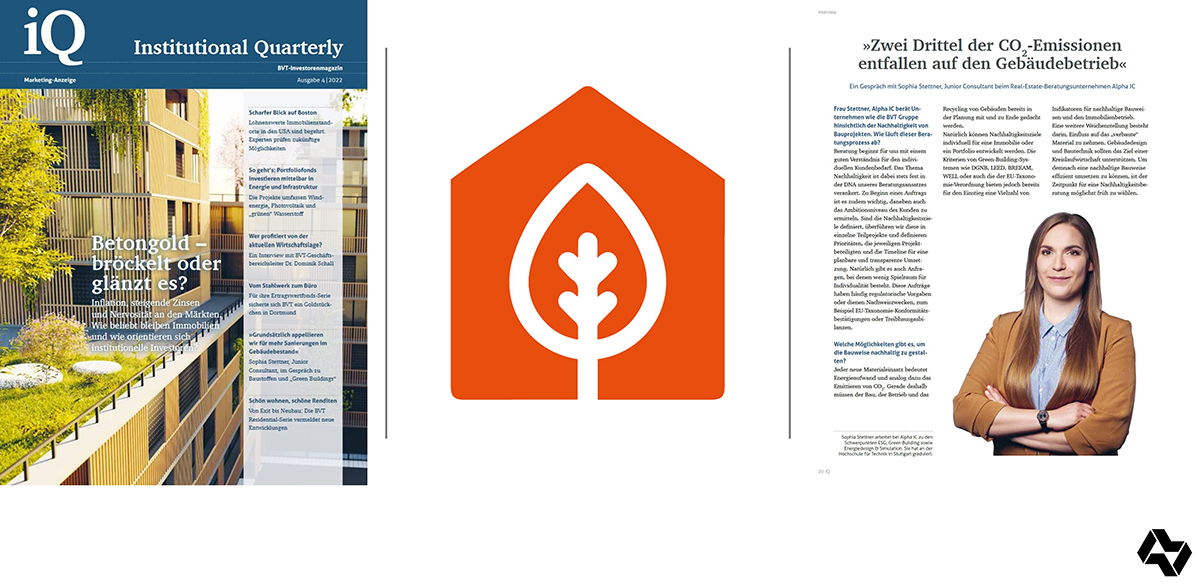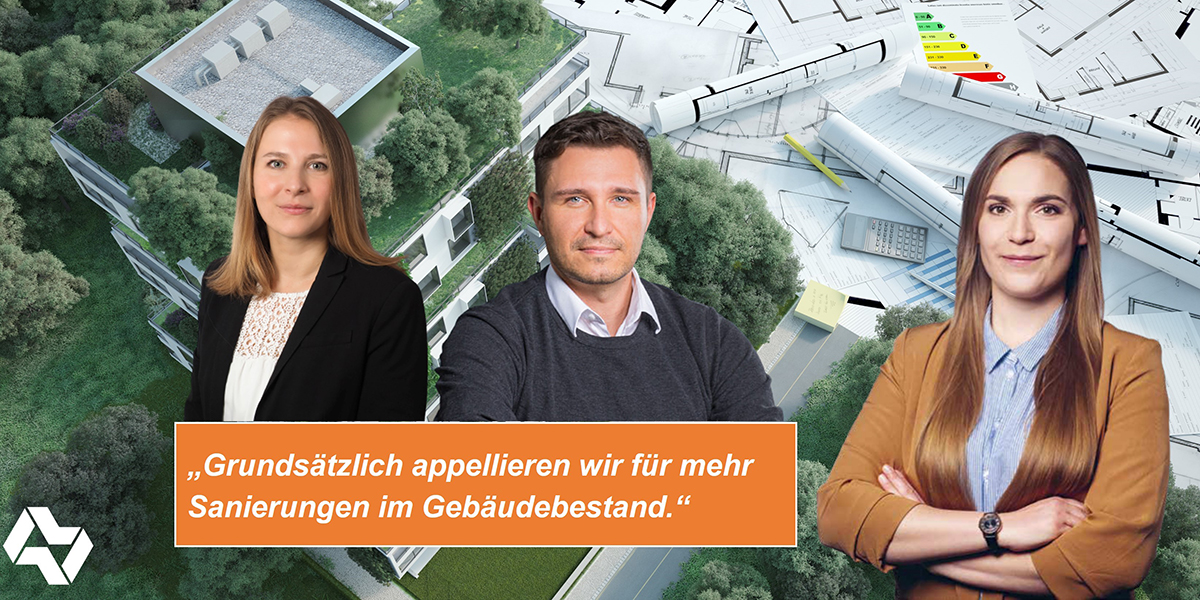Our consulting colleague Sophia Stettner talked to the BVT investor magazine Institutional Quaterly (iQ) about advising on sustainable construction projects. The interview was published in issue 04-2022. The detailed answers to the interview questions were compiled by our colleagues Piera Walter and Daniel Kozik together with Sophia. Here in our journal you can now find the long version of the interview with the more detailed answers of the entire team of authors:
Alpha IC advises companies, such as the BVT Group, on the sustainability of construction projects. How does this consulting process work?
For us, consulting begins with a good understanding of the individual client's needs. The topic of sustainability is always firmly anchored in the DNA of our consulting approach. In the case of strategic issues, it is important at the beginning of an assignment to determine not only the client's needs but also their level of ambition. Consulting according to a "one size fits all" approach would be the wrong approach here and would not satisfy clients and consultants. Once the level of ambition is defined, the sustainability goals are translated into individual sub-projects and the priorities and timeline for implementation are defined. This ensures that the client's organisation is not overwhelmed during implementation and that the right contacts on the client and consultant side are brought together for each topic.
Of course, there are also requests where the implementation leaves little room for individuality. These requests often have regulatory requirements or serve transparency or verification purposes (e.g. EU taxonomy compliance confirmations or the preparation of greenhouse gas balances). Translated with www.DeepL.com/Translator (free version)
What options are there for making construction sustainable?
To answer this question comprehensively would go beyond the available scope. One thing is clear, however - every new material used means energy expenditure and, analogously, the emission of CO2. This means that new construction is at a disadvantage in terms of resource efficiency and decarbonisation compared to existing real estate. Nevertheless, construction activities cannot be stopped completely, because further living space in particular is urgently needed. However, one has to rethink the construction, operation and recycling of buildings.
Of course, sustainability goals can be developed individually for the property or a portfolio. However, the criteria of green building systems (e.g. DGNB, LEED, BREEAM, WELL) or even those of the EU Taxonomy Regulation already offer a large number of indicators for sustainable construction methods and property operation for starters. Here, in addition to ecological topics, socio-cultural and process-related aspects are also given a higher priority. In order to be able to implement a sustainable construction method, the time for sustainability consulting should be chosen as early as possible (e.g. for preliminary design planning). The point of entry is often underestimated and subsequently strains the budget.
Another way of setting the course is to influence the material that is "used". We recommend carrying out an analysis of the greenhouse gas potentials resulting from the construction for each life cycle phase of a building. Based on this, the building design and construction technology should support the goal of a circular economy by being resource-efficient, adaptable, flexible, pollutant-free and demountable, and at least half (by weight or surface area) should consist of a combination of reused components, recycled or responsibly sourced renewable materials.
We also advise a climate risk assessment to reduce the vulnerabilities of the construction project to the challenges of climate change.
So here are all three authors of the interview. From left: Our former consulting colleague Piera Walter, Daniel Kozik, Senior Consultant with a focus on Green Building and Facility Management, and Sophia Stettner, who works in the Alpha IC team on ESG, Green Building and Energy Design & Simulation.
Especially, but not only in the USA, wood is currently booming as a building material. What exactly makes timber construction so attractive?
The most prominent advantages over mineral building materials are obvious: wood can have a long-term positive effect on the climate balance of a property due to the storage of CO2 in the growth phase and the delayed release of the stored CO2, and it is also a renewable resource.
Furthermore, serial prefabrication enables simplified transport and shortened construction times, thus making an additional contribution to the reduction of energy and CO2. Last but not least, the advantages of wood in terms of building physics are likely to contribute to its attractiveness (e.g. healthy indoor climate, comfortable living atmosphere, moisture-regulating and good insulating properties). However, the origin of the wood and its sustainable management play a decisive role for the harmless use of wood in the construction industry.
Can concrete construction compete with this at all?
With a focus on the circular economy and the possibility of binding CO2 over the life cycle of a property, concrete has a disadvantage compared to timber construction. From our point of view, it has to be decided here which construction makes sense depending on the application, because concrete also stands for itself with some advantages - from thermal storage capacity (heating & cooling) to acoustics and statics.
Nevertheless, due to dwindling sand resources and the enormous energy input in concrete production, we will have to rethink in the future and increasingly compensate by substituting or supplementing it with other materials. With the advancing market for recycling, which makes it easier to possibly reuse entire building components, concrete can also continue to assert itself as a building material. Hybrid solutions of wood and mineral materials also often offer a sensible alternative here.
Even though we are in the construction phase, we advise our clients not to overlook the energy performance and operation of the property.
Which building materials are also relevant for sustainable building in the future?
From our point of view, the building material pyramid provides a good orientation to become aware of the CO2 impact of a building material for a project and to discuss the level of material use. However, as mentioned before, any new material use should be minimised. A good compromise is to use recycled or reused materials. In this way, even an energy-intensive building material such as concrete can be produced in a largely CO2-neutral way in the future and consist of a high proportion of recycled and reused material.
And not to be neglected: Here, too, attention must be paid to a low-pollutant choice of building material and construction method. For example, the increased use of wood can have a negative impact on indoor air hygiene if attention is not paid to low-emission products (e.g. avoid glued products such as glued laminated timber).
Sustainability also includes recycling existing buildings and their building materials. How can existing buildings be made more sustainable?
Experience shows that often two thirds of greenhouse gas emissions are due to the operation of the building and only one third is due to its manufacture, construction and deconstruction at the end of its life. Depending on the objective, we would therefore advise every owner, regardless of the construction method, to optimise the operational CO2 emissions first, as this is where the greater leverage lies hidden.
Basically, we appeal for more renovation of existing buildings. After all, the building sector is currently one of the world's largest emitters and every new building must be critically examined for its necessity.
For initial orientation, we would like to refer once again to the current green building systems. These have compiled a large number of sustainability targets with corresponding sustainability indicators for evaluation and measurement. For each property, it is necessary to identify suitable ones and to constantly optimise the sustainability performance in the operation of the property.
What options do investors have to find out about the sustainability of a project in advance?
There are now a wide variety of options here: ESG ratings for the companies behind the real estate are one possibility: the ratings show risks from ESG processes and governance standards of a company.
In the case of financial products, information on the sustainability performance of the real estate portfolios they contain can be obtained from the fund prospectuses, the annual reports and the transparency obligations under the Disclosure Regulation. In addition, binding specifications for the sustainability goals of the financial product should be defined in the investment limits. The investment limits bind the manager of the financial product to a corresponding investment profile and the corresponding management of the properties.
An (ESG) due diligence also provides information on the sustainability risks and opportunities of a property or portfolio. Often, the specific decarbonisation path and the EU taxonomy compliance of the property are already subjected to a preliminary review.
Click here for the printed published interview in iQ Magazine 04-2022: https://www.yumpu.com/de/document/read/67429158/iq-04-2022
Your contact persons for sustainable building projects:
Sophia Stettner, Consultant, Alpha IC
Tel. +49 151 422 294 - 09 ∙ s.stettner@alpha-ic.com
- Green Building
- ESG & CSR
- Energiedesign & Simulation
Daniel Kozik, Senior Consultant, Alpha IC
Tel. +49 151 422 294 - 13 ∙ d.kozik@alpha-ic.com
- Green Building
- Facility Management






